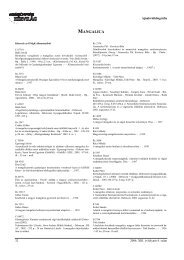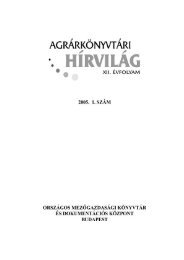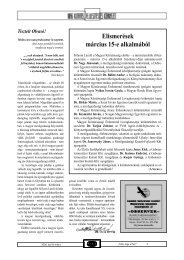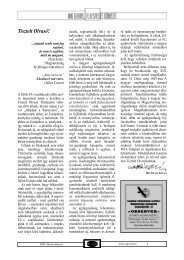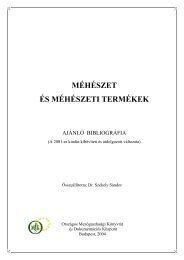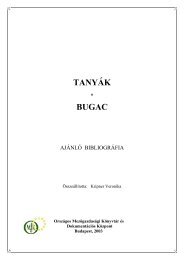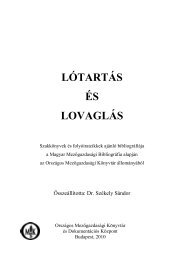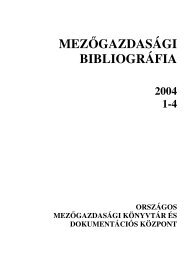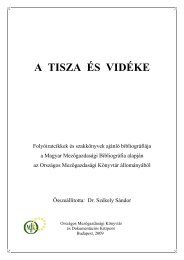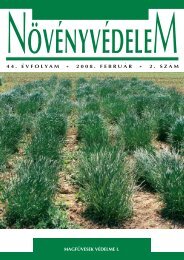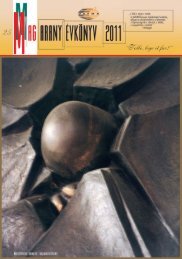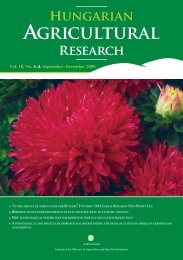2009/9. - Országos MezÅgazdasági Könyvtár
2009/9. - Országos MezÅgazdasági Könyvtár
2009/9. - Országos MezÅgazdasági Könyvtár
You also want an ePaper? Increase the reach of your titles
YUMPU automatically turns print PDFs into web optimized ePapers that Google loves.
NÖVÉNYVÉDELEM 45 (9), <strong>2009</strong> 521<br />
mesztés melyik fázisában (komposztkészítés,<br />
csírázás, átszövetés, termôre fordítás stb.) célszerû<br />
a baktérium kijuttatása.<br />
A kutatómunkát az NKTH 4/033-04 számú<br />
pályázat tette lehetôvé.<br />
IRODALOM<br />
Antal, Z., Hatvani, L., Kredics, L., Szekeres, A.,<br />
Manczinger, L., Vágvölgyi, Cs. and Nagy, E.<br />
(2005): Polymorphism of mitochondrial DNA among<br />
Trichoderma strains obtained from mushroom farms.<br />
Acta Microbiologica et Immunologica Hungarica, 52<br />
(S): 54–55.<br />
Domsch, K.H., Gams ,W. and Anderson, T.H. (1980):<br />
Compendium of Soil Fungi, Vol.1., Academic Press,<br />
London.: 794–80<strong>9.</strong><br />
Fletcher, J.T. and Gaze, R.H. (2008): Mushroom, Pest and<br />
Diseases Control, Academic Press, Boston and San<br />
Diego, 84–8<strong>9.</strong><br />
Geels, F. P. (1997): Rondetafel-bijeenkomst over Trichoderma.<br />
Champignoncultuur, 41–43.<br />
Geml J., Hajdú Cs. és Szarvas J. (2000): Zöldpenészek a<br />
gombatermesztésben. Magyar Gombahíradó,<br />
MGOSZ, VIII. (27): 8–<strong>9.</strong><br />
Grogan, H.M., Scruby, A. and Harvey, L. (2000): Moulds in<br />
spawn-run compost and their effect on mushroom<br />
production. Mushroom Science, XV. (2): 609–615.<br />
Gyôrfi J. (2002): Zöldpenészek, Trichoderma fajok. Magyar<br />
Gomba, (18.): 28–2<strong>9.</strong><br />
Hatvani, L., Antal, Z., Manczinger, L., Druzhinina, I.S.,<br />
Kubicek, C.P., Szekeres, A., Vágvölgyi, Cs., Nagy,<br />
E. és Kredics, L. (2006): Monitoring the occurrence<br />
of Trichoderma species during compost production<br />
and cultivation of Agaricus bisporus in Hungary. Acta<br />
Microbiologica et Immunologica Hungarica, 53 (3.):<br />
272.<br />
Hatvani, L., Antal, Z., Manczinger, L., Szekeres, A.,<br />
Druzhinina, I.S., Kubicek, C.P., Nagy, A., Nagy, E.,<br />
Vágvölgyi, Cs. és Kredics, L. (2007): Green mold<br />
diseases of Agaricus and Pleurotus spp. are caused by<br />
related but phylogenetically different Trichoderma species.<br />
Phytopathology, 97 (4): 532–537.<br />
Hatvani, L., Kredics, L., Szekeres, A., Antal, Zs., Nagy, A.,<br />
Manczinger, L. és Vágvölgyi, Cs. (2005): Genetic<br />
diversity of Trichoderma strains and occurence of T.<br />
aggressivum in Hungarian mushroom compost and<br />
substrate samples. Acta Microbiologica et<br />
Immunologica Hungarica, 52 (S): 55.<br />
Kredics, L., Antal, Zs., Manczinger, L., Szekeres, A., Kevei,<br />
F. és Nagy, E. (2003): Influence of environmental<br />
parameters on Trichoderma strains with biocontrol<br />
potential. Food Technology and Biotechnology, 41<br />
(1): 37–42<br />
Oei, P. (2003): Mushroom cultivation. Backhuys Publishers<br />
Leiden, The Netherlands. 378–37<strong>9.</strong><br />
Rinker, D.L. and Alm, G. (2000): Management of green<br />
mould disease in Canada. Mushroom Science, XV<br />
(2): 617–623.<br />
Rinker, D.L., Dano, J., Sivanesan, D., Dobbin, C., Mathani,<br />
H., Alm, G., Cline, J. and Castle, A. (2008): Spotting<br />
and Discoloration of the Cultivated Mushroom,<br />
Agaricus bisporus: Some Issues to Consider.<br />
Proceedings of Sixth International Conference on<br />
Mushroom Biology and Mushroom Products. 128–<br />
13<strong>9.</strong><br />
Vajna L. (1984): Trichoderma fajok és alkalmazásuk a növényi<br />
gombabetegségek elleni védekezésben. Növényvédelem,<br />
20: 193–201.<br />
TRICHODERMA SPECIES IN COMMON MUSHROOM CULTIVATION: IS THERE ANY<br />
FEASIBLE BIOLOGICAL CONTROL?<br />
Gyôrfi Júlia and A. Geösel<br />
Corvinus University of Budapest, Faculty of Horticultural Science, Department of Vegetable and Mushroom Growing<br />
H-1118 Budapest, Ménesi út 44.<br />
Past years the threats of pathogens increase in mushroom cultivation, especially the Trichoderma<br />
(green mold) may endanger the yield. The disease control of this pathogen has many problems<br />
because no chemical agent is licensed, and only high quality cultivational technology can be used<br />
onto the elimination of damaging. Few years ago researches started to measure and characterize the<br />
different Trichoderma spp. in Hungary, to develop a biocontrol product against the pathogen.<br />
Bacterium with antifungal activity were selected in laboratory; these bacteria were success in<br />
retardation of Trichoderma’ in vitro’ growing. The aim of our present study was to test these<br />
antagonist bacteria ‘in vivo’ in experimental mushroom cultivation circumstances. Our data<br />
demonstrates, some bacterium can block the growing of harmful Trichoderma in 2 nd Phase<br />
mushroom compost. The selected bacterium can increase the yield and production safety. At our<br />
present knowledge this is the first report where isolated and exactly identified Trichoderma were<br />
treated by antagonist bacterium in mushroom cultivation.<br />
Érkezett: 2008. november 14.



